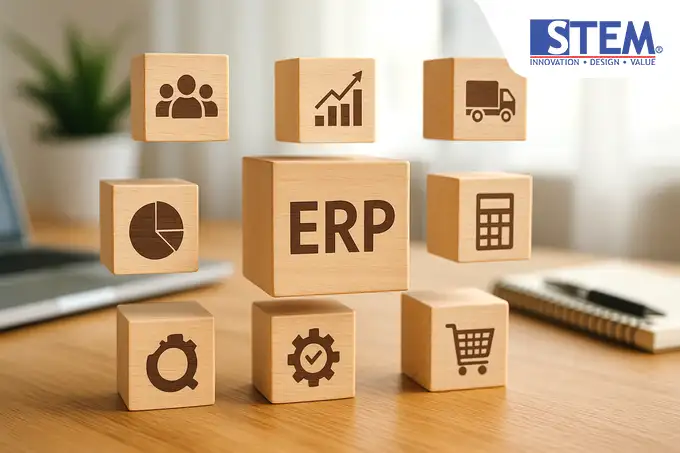Have you ever felt like playing a never-ending game of hide and seek with your own company’s data? The sales team records orders via WhatsApp, the warehouse team checks inventory using a notebook, and finance scrambles to consolidate everything in an Excel sheet filled with #REF! errors. When you ask, “What was our net profit yesterday?” the answer is often, “Hold on, I need to compile the data first.”
This might sound amusing when told as a story, but it’s a nightmare to live through daily. This situation is a textbook case of a data silo—where every department stores its data in isolated silos, disconnected and unaware of each other.
Enter the unsung hero with a glamorous name: ERP (Enterprise Resource Planning).
Don’t worry—this isn’t a headache-inducing technical manual. Forget the jargon for a moment. Think of this article as a relaxed conversation over coffee, unraveling what ERP really is, why your business may need it, and how it can rescue you from the chaos of fragmented data.
What is ERP?
Imagine your company as a large house with many rooms: a living room (Sales), a kitchen (Production), a pantry (Inventory), and a home office (Finance).
Before ERP, each room had its own locked cabinet and secret notes. The folks in the living room had no clue what was cooking in the kitchen. The kitchen staff didn’t know what ingredients remained in the pantry. Everyone had to shout or send scribbled notes to each other. Messy and inefficient.
ERP is both the master key and the central bulletin board of that house.
With ERP, every room is connected. One central system handles it all:
- When someone in Sales sells 5 cakes, Production gets an instant alert to start baking.
- As Production begins, the system automatically deducts flour and eggs from the Inventory ledger.
- If stock levels fall too low, the system notifies Finance or Purchasing to replenish.
- Every transaction is logged instantly in the financial reports—income and costs accounted for.
In simple terms:
ERP is a unified software platform that ensures all departments operate on the same system, share the same data, and speak the same language—in real-time.
The keyword is INTEGRATION. No more version A, B, or C of the truth. Just one single source of data accuracy for the entire company.
A Glimpse into Core ERP Modules

ERP systems are modular—like building blocks that you can mix and match based on your business needs. You don’t have to use them all. Here are the vital organs found in most ERP systems:
1. Financial & Accounting Module
- Problems Solved: Late financial reports, manual invoicing, and difficulty tracking receivables and payables.
- ERP’s Answer: The heart of any ERP. All transactions feed into this module. Journals, ledgers, profit & loss, balance sheets, and cash flow statements can be generated with a few clicks. You gain real-time financial insights, not just end-of-month reports.
2. Inventory Management Module
- Problems Solved: Discrepancies between recorded and actual stock, stress-inducing stock-taking, dead stock, or missing hot-selling items.
- ERP’s Answer: Real-time stock visibility across all warehouses. Track every item’s movement, set minimum thresholds for reordering, and analyze inventory turnover to optimize operations.
3. Sales & CRM Module
- Problems Solved: Scattered customer data, lost sales histories, difficulty monitoring the sales team’s performance.
- ERP’s Answer: Centralized customer records and interactions—from quotations to orders, deliveries, and invoicing. Sales pipelines and performance metrics become instantly accessible.
4. Purchasing Module
- Problems Solved: Unstructured procurement processes, lack of pricing comparisons, and convoluted approval workflows.
- ERP’s Answer: Standardizes the flow from purchase requests to purchase orders. Simplifies tracking and supplier performance review.
5. Manufacturing Module
- Problems Solved: Especially critical for factories—challenges in calculating accurate production costs and chaotic scheduling.
- ERP’s Answer: Manages product recipes (Bill of Materials), calculates raw material needs, issues work orders, and tracks costs at every production stage.
Real Benefits, Not Just Marketing Hype
Now that you’ve seen the modules, here’s what ERP delivers:
- Unmatched Efficiency: Manual tasks that once took hours (like compiling daily sales reports) are now automated. Your team can focus on strategy, not data entry.
- 360-Degree Visibility: As an owner or manager, you gain a holistic view of your business via one dashboard—no more chasing department heads.
- Data-Driven Decisions: Want to launch a new product or open a branch? Make decisions backed by accurate sales, cost, and inventory data—not gut feeling.
- Process Standardization: ERP enforces best practices across the organization, reducing human error and making scaling easier.
- Happier Customers: With real-time stock data and faster order processing, customer expectations are met reliably.
Real-World Examples of ERP in Action
- F\&B Distributors: Manage thousands of SKUs, track expiry dates, optimize sales routes, and automate invoicing for thousands of retailers.
- Furniture Manufacturers: Precisely calculate the amount of wood, nails, and paint needed per chair. Know exactly how much each chair costs and its delivery timeline.
- Construction Services: Manage project-specific budgets, track material purchases, and monitor labor hours to prevent losses.
In short, ERP is no longer a luxury for the corporate elite. It’s a lifeline for fast-growing SMEs that need a strong foundation to scale without collapsing under operational strain.
Now you understand what ERP is and why it matters. The next step is figuring out how to choose the right one—because the wrong ERP can be costly.
To guide you through that process, continue to our definitive guide:
The Complete Guide to Choosing the Best ERP Software for Your Business in 2025
Ready to Take the First Step?
Theory alone isn’t enough. You might be wondering, “Which modules do I need for my specific business? Which software suits me best?”
Don’t rely on guesswork. The best approach is to speak with seasoned professionals. The experts at PT. Sterling Tulus Cemerlang are ready to analyze your unique business requirements and present the most suitable solution.
They are certified consultants of SAP Business One—one of the world’s most trusted ERP solutions, proven effective for SMEs and growing enterprises.
Book a free consultation to map your needs—no obligations, no pressure.


